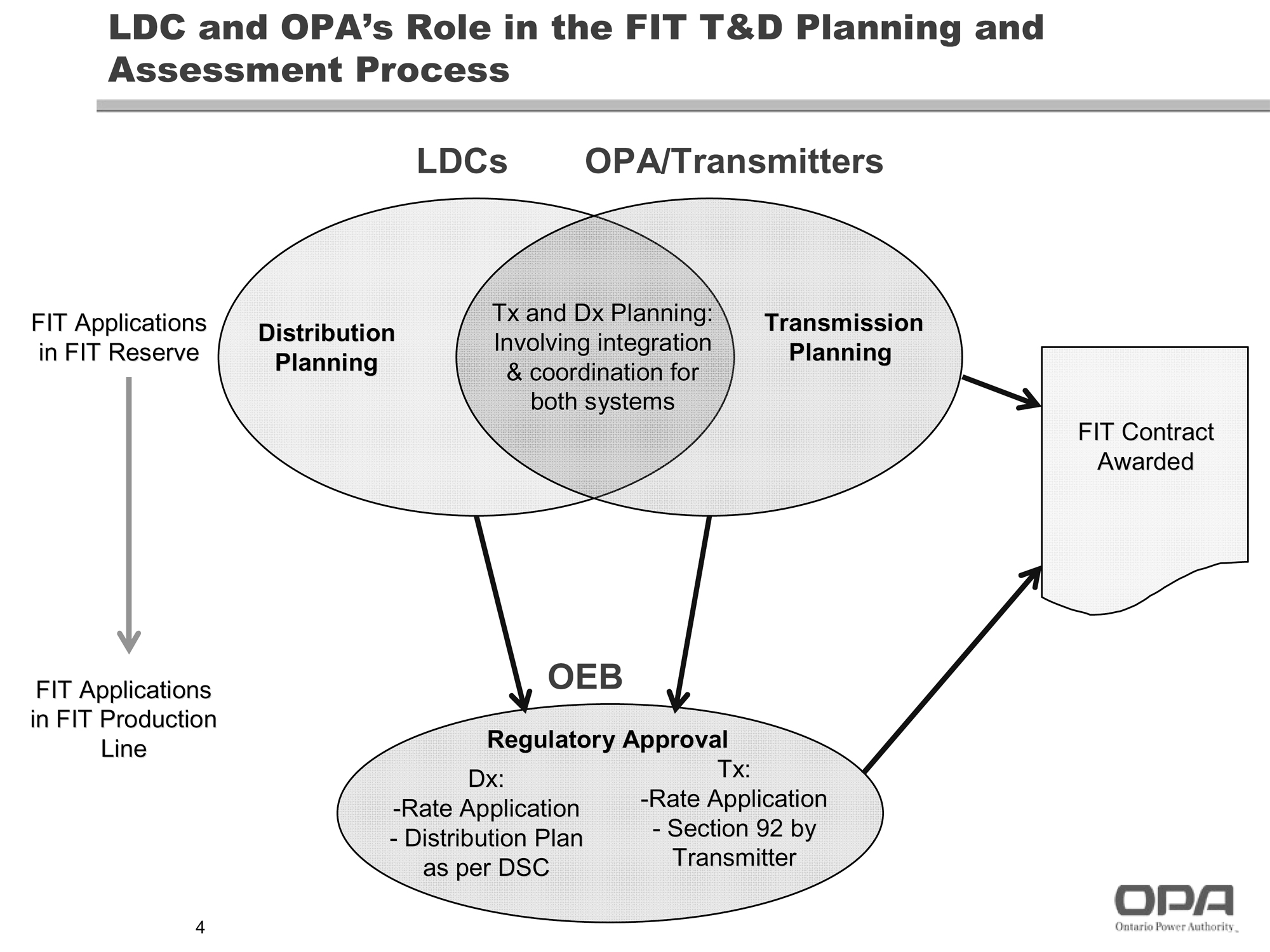Toronto: The starting bell rang on October 1 and an extensive array of developers and investors began working intensively on renewable energy projects to be located in Ontario. “This is likely to be one of the greatest upswings in renewable energy development in the history of the province,” said APPrO Executive Director Jake Brooks. With no upper limits on project size or the total amount to be contracted, and a range of new measures to encourage renewable energy development, the prospects for a major increase in the number of projects and total renewable energy capacity have probably never been better at any time in the history of Ontario, and possibly Canada. Positioned not just as a clean energy program but also as a means of encouraging the development of environmentally-oriented industry in Ontario, there is potential for growth in a range of manufacturing and service industries related to renewable energy in the near term.

The FIT program resembles a wide-ranging sporting event more than a single competitive race, in that all participants are incented to perform to their best, and they are judged on a number of different measures over time. Even though developers will not be competing with each other on price, they have natural incentives to minimize their costs and are already competing on a range of other factors such as locating the best sites, securing early time-stamps in the FIT production line, getting environmental approvals, and establishing conducive community relations. For those projects that are eligible for the OPA’s “initialization window,” a series of additional qualifications will need to be met quickly. This kind of procurement system, making assured pricing available to generators over an extended period of time, is believed by many to help foster the growth of a stable domestic industry that will ultimately lead to cost efficiencies and economic development. A number of renewable energy companies have recently set up or expanded offices in Ontario, and more are expected to follow.
Prices offered in the FIT program are guaranteed for 20 years, subject to adjustments as per the program rules and contract. Eligible waterpower projects can get 40 year contracts.
Brooks thinks that one of the most significant bottlenecks for new development will be the development of new transmission and distribution connection capacity. “Ontario’s distribution system was generally designed for one-way power flow, and both it and the transmission system will need upgrades to accommodate all the new generation anticipated,” he says. However, major upgrades are being planned. “The province will likely end up with a much more resilient and flexible grid as a result, and can use the opportunity of system expansion and reinforcement to improve service and reliability in a number of ways.” The new connection system developed as part of the FIT program includes regular systematic assessments of opportunities for grid expansion, and this process, known as the Economic Connection Test, will be a key determinant of which projects are able to connect to the grid and when.
APPrO was one of the earliest advocates of a standard offer program for small scale renewable and clean energy and has consistently supported the development of the FIT program as part of a balanced supply procurement framework. President Dave Butters described the program as “a very bold step toward the future and it will change the way we think about the electricity system and its relationship to our society.” The new FIT program is capable of bringing out a wide range of renewable energy projects, both large and small scale, commercial and community based, he noted, adding that it has the potential to encourage the growth of a very diverse renewable energy industry based in Ontario.
However, Butters expressed disappointment that the government had not yet changed the proposed setback of 550 metres for wind turbines. APPrO recommended a more flexible approach based on decibel levels. It believes this “would be the right balance between program success and health and safety issues, and would encourage quieter technologies.” While Butters predicted that the setback will have a negative impact on program uptake and success initially, he said that generators were hopeful that over time, working with the government, a more effectively targeted set of rules producing more satisfactory results for all concerned could be achieved.
Butters said that, overall, APPrO is encouraged that the set of announcements related to the FIT program will produce significant benefits. In particular, he noted that with the transmission and distribution investments as proposed, “Ontario can achieve an environmentally and economically sustainable electricity sector that ensures adequacy, reliability, and the optimal environmental footprint and electricity cost for Ontario consumers – and supports the business interests of electricity generators. If our energy policies are forward-looking and well-balanced we will be able to ensure the right kind of energy for consumers of all kinds, whenever they need it, at a price they can afford.”

The basic outlines of the program were developed in the context of a series of consultations held by the Ontario Power Authority between March and June of this year. The rules are designed not just to bring forward large amounts of renewable energy but also to encourage the development of power projects by a range of entities including First Nations and Métis communities, homeowners, farmers, schools, stores, factories, co-ops, offices and larger-scale commercial generators.
The Feed-in Tariff Program is a key part of the province’s implementation of its Green Energy Act. It is one of a series of initiatives brought forward in September titled “Ontario’s Ten Steps To Green Energy.” The steps include the following:
1. Closure of four coal-fired power units in 2010, four years ahead of the 2014 target.
2. The Aboriginal Energy Partnerships Program, to build capacity and participation through support for community energy plans, funding for feasibility studies and the development of an Aboriginal Renewable Energy Network.
3. The Aboriginal Loan Guarantee program (ALGP), which makes Aboriginal communities eligible for loan guarantees to take on equity participation in renewable generation and transmission projects.
4. Grid development: Instructing Hydro One to begin work on 20 transmission and distribution projects over the next three years. Six core transmission network upgrades are moving forward, including North-South lines from Sudbury to Barrie and Barrie to the Greater Toronto Area and an East-West line from Nipigon to Wawa. Another series of core-supporting transmission projects and distribution upgrades are also moving ahead.
5. The Community Energy Partnerships Program, which will assist communities in Ontario, including farmers, co-ops and non-profit organizations, to bring forward green energy projects by providing one-time support with the “soft” or developmental costs.
6. The Municipal Renewable Energy Program, which will provide support to municipalities for costs associated with new renewable energy projects.
7. Establishment of the Renewable Energy Facilitation Office (REFO), a one-window access point to assist developers, communities and municipalities obtain information on developing renewable energy projects in Ontario, and help them navigate through the regulatory approvals necessary to develop projects.
8. The Renewable Energy Approval (REA) process, intended to simplify and expedite the process of obtaining permits and approvals for renewable energy projects, in a way that is “protective of human health, the environment, and Ontario’s cultural and natural heritage.”
9. Domestic content requirements that are expected to ensure that at least 25 per cent of wind projects and 50 per cent of large solar projects are produced in Ontario.
10. The Feed-in Tariff Program.
These steps were largely made possible through the changes created by the Green Energy Act, introduced in February 2009. One of the more innovative aspects of the program is the extent to which it is designed to encourage new entities to enter the generation business.
With the help of the Renewable Energy Facilitation Office, and financial assistance through the Community Energy Partnerships Program, the Aboriginal Loan Guarantee program, and the Municipal Renewable Energy Program, there is no telling how many new players will enter the generation business.
One of the key issues in the finalization of the program were the rules governing how close new wind turbines may be placed in relation to lot lines, roads and buildings. Additional regulations limit the use of prime agricultural land for solar installations.
The new rules, which are much more restrictive than those in place before, were intended to ensure that development could proceed while respecting high environmental standards. Further development in these areas is anticipated by APPrO and others.
There is also a micro-FIT program for small scale projects, up to 10 kW, along with simplified environmental and permitting requirements.
To access a multitude of online resources about the Feed-in Tariff program, simply visit APPrO’s magazine website at this location: https://magazine.appro.org/FIT.html.
On this page you will find links to the FIT program itself, to the IESO and Hydro One programs related to FIT, to commentary and analysis by a range of experts on the program, APPrO’s own news stories and comments on FIT, and much more.
